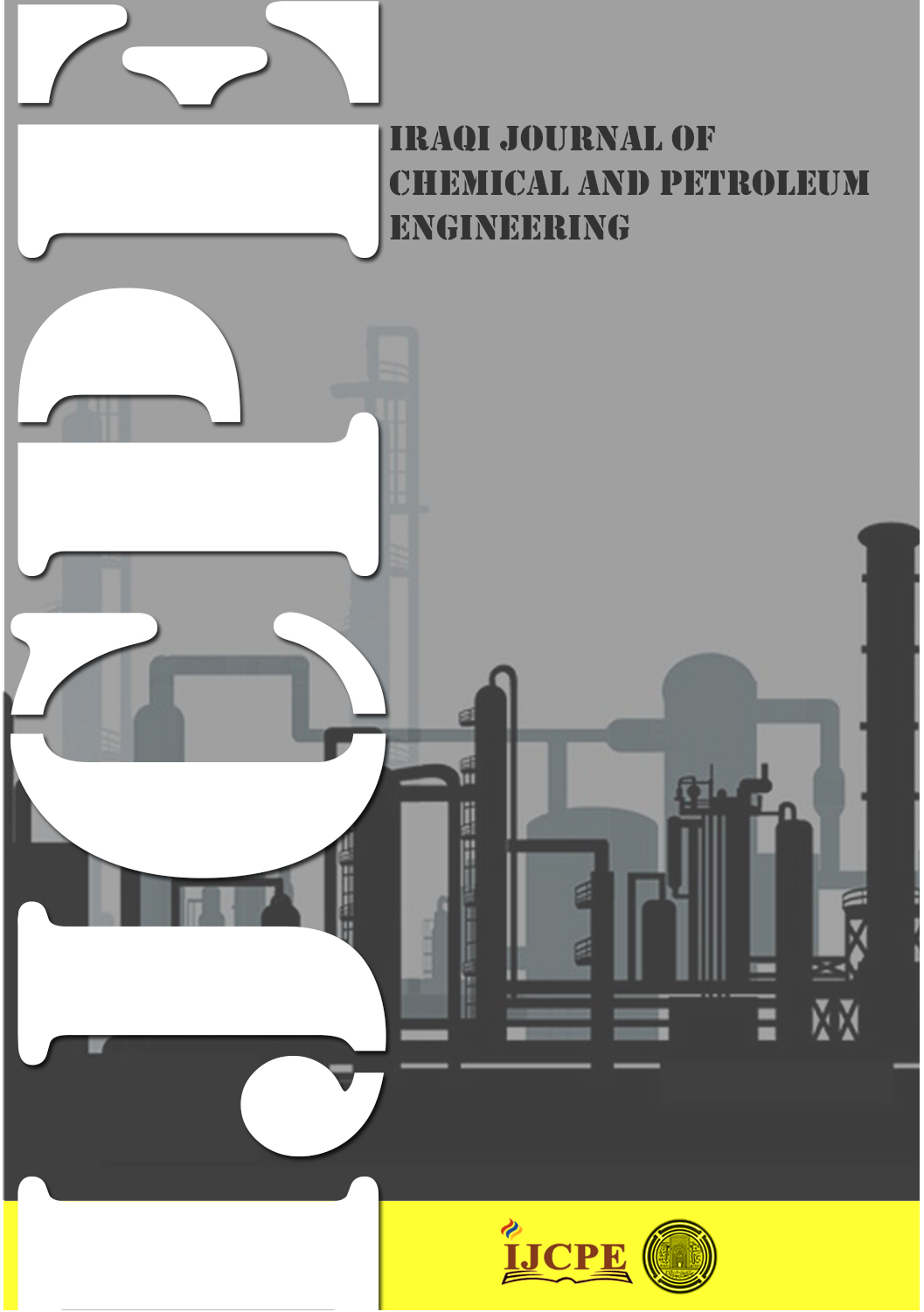Simulation of two-phase flow and mass transfer of CO2 bubbles in a sweetener solution by horizontal pipe using Comsol
DOI:
https://doi.org/10.31699/IJCPE.2025.1.5Keywords:
Two-phase Flow; COMSOL CFD; mass Transfer; CO2 bubbles; Horizontal pipeAbstract
This research investigated the two-phase flow behavior and mass transfer of CO2 bubbles in a water-sucrose solution in a horizontal pipe. The process used A Computational Fluid Dynamic (CFD) model that offers diverse applications in numerous industries. The simulation of two-phase flow with mass transfer is carried out using COMSOL® software version 5.6 and compared with experimental results. The model verified satisfactory concurrence with the experimental data. Multivariable such as concentration, velocity, and share rate were studied under different conditions (gas flow rate, liquid flow rate, bubble diameter, pipe diameter, and sucrose concentration). The gas flow rate was varied at the inlet, with values of (0.2, 0.45, and 0.7 L/min) for CO2 and (2, 4, and 6 L/min) for the sweeteners solution. The diameter of the bubbles ranged from (2 to 4 mm). The pipe diameter was (1.25 and 1.9 cm), and the sucrose concentration in the sweetener solution was (150 g/L). It was observed that the effect of bubble diameter was inversely to CO2 concentration, and the gas and liquid flow rates were directly proportional to concentration. The concentration of CO2 decreases as the concentration of sucrose increases. The relationship between bubble diameter and gas phase velocity was inverse, as well as studying the effect of variables on share rate.
Received on 21/01/2024
Received in Revised Form on 13/07/2024
Accepted on 13/07/2024
Published on 30/03/2025
References
[1] D. Kregiel, “Health safety of soft drinks: contents, containers, and microorganisms,” BioMed Research International, vol. 2015, 2015, pp. 1–15. https://doi.org/10.1155/2015/128697
[2] G. Kocamustafaogullari and W. D. Huang, “Internal structure and interfacial velocity development for bubbly two-phase flow,” Nuclear engineering and design, vol. 151, no. 1, 1994, pp. 79–101. https://doi.org/10.1016/0029-5493(94)90035-3
[3] A. B. Desamala, A. K. Dasamahapatra, and T. K. Mandal, “Oil-water two-phase flow characteristics in horizontal pipeline–a comprehensive CFD study,” International journal of Chemical, Molecular, Nuclear, Materials and Metallurgical Engineering, World Academy of Science, Engineering and Technology, vol. 8, no. 4, 2014, pp. 360–364.
[4] M. E. Nakhchi and J. A. Esfahani, “CFD approach for two-phase CuO nanofluid flow through heat exchangers enhanced by double perforated louvered strip insert,” Powder Technology, vol. 367, 2020, pp. 877–888. https://doi.org/10.1016/j.powtec.2020.04.043
[5] A. Boemer, H. Qi, and U. Renz, “Eulerian simulation of bubble formation at a jet in a two-dimensional fluidized bed,” International Journal of Multiphase Flow, vol. 23, 1997, pp. 927–944. https://doi.org/10.1016/s0301-9322(97)00018-9
[6] M. H. Zawawi, M. G. Swee, N. S. Zainal, N. M. Zahari, M. A. Kamarudin, and M. Z. Ramli, “Computational fluid dynamic analysis for independent floating water treatment device,” in AIP Conference Proceedings, 2017. https://doi.org/10.1063/1.5002316
[7] J. Parekh and R. Rzehak, “Euler–Euler multiphase CFD-simulation with full Reynolds stress model and anisotropic bubble-induced turbulence,” International Journal of Multiphase Flow, vol. 99, 2018, pp. 231–245. https://doi.org/10.1016/j.ijmultiphaseflow.2017.10.012
[8] Z. Yang, “On modeling of CO2 two-phase flow in a near horizontal pipe,” in Proceedings of the 16th Greenhouse Gas Control Technologies Conference (GHGT-16) 23-24 Oct, 2022. https://doi.org/10.2139/ssrn.4274197
[9] R. A. Mahmood, D. Buttsworth, R. Malpress, and A. Sharifian-Barforoush, “CFD numerical and experimental investigation of two-phase flow development after an expansion device in a horizontal pipe,” Journal of Thermal Engineering, vol. 7, no. 1, 2021, pp. 307–323. https://doi.org/10.18186/thermal.850672
[10] U. Khan, W. Pao, N. Sallih, and F. Hassan, “Identification of horizontal gas-liquid two-phase flow regime using deep learning,” CFD Letters, vol. 14, no. 10, 2022, pp. 68–78. https://doi.org/10.37934/cfdl.14.10.6878
[11] G. Kocamustafaogullari and Z. Wang, “An experimental study on local interfacial parameters in a horizontal bubbly two-phase flow,” International journal of multiphase flow, vol. 17, no. 5, 1991, pp. 553–572. https://doi.org/10.1016/0301-9322(91)90024-w
[12] G. Kocamustafaogullari and W. D. Huang, “Internal structure and interfacial velocity development for bubbly two-phase flow,” Nuclear engineering and design, vol. 151, no. 1, 1994, pp. 79–101. https://doi.org/10.1016/0029-5493(94)90035-3
[13] R. Maceiras, X. R. Nóvoa, E. Alvarez, and M. A. Cancela, “Local mass transfer measurements in a bubble column using an electrochemical technique,” Chemical Engineering and Processing-Process Intensification, vol. 46, no. 10, 2007, pp. 1006–1011. https://doi.org/10.1016/j.cep.2007.05.010
[14] K. Ekambara, R. S. Sanders, K. Nandakumar, and J. H. Masliyah, “CFD simulation of bubbly two-phase flow in horizontal pipes,” Chemical Engineering Journal, vol. 144, no. 2, 2008, pp. 277–288. https://doi.org/10.1016/j.cej.2008.06.008
[15] J. E. Olsen, D. Dunnebier, E. Davies, P. Skjetne, and J. Morud, “Mass transfer between bubbles and seawater,” Chemical Engineering Science, vol. 161, 2017, pp. 308–315. https://doi.org/10.1016/j.ces.2016.12.047
[16] A. F. Melo Zambrano and N. Ratkovich, “CFD modeling of Air-Water Two-phase Annular Flow before a 90° elbow,” Revista De Ingenieria, no. 43, 2015, pp. 16–23. https://doi.org/10.16924/riua.v0i43.843
[17] F. R. Menter, “Two-equation eddy-viscosity turbulence models for engineering applications,” American Institute of Aeronautics and Astronautics Journal, vol. 32, no. 8, 1994, pp. 1598–1605. https://doi.org/10.2514/3.12149
[18] J. J. Carroll, J. D. Slupsky, and A. E. Mather, “The solubility of carbon dioxide in water at low pressure,” Journal of Physical and Chemical Reference Data, vol. 20, no. 6, 1991, pp. 1201–1209. https://doi.org/10.1063/1.555900
[19] C. W. Bowman and A. I. Johnson, “Mass transfer from carbon dioxide bubbles rising in water,” Canadian Journal of Chemical Engineering, vol. 40, no. 4, 1962, pp. 139–147. https://doi.org/10.1002/cjce.5450400404
[20] E. Alvarez, M. A. Cancela, J. M. Navaza, and R. Taboas, “Mass transfer coefficients in batch and continuous regime in a bubble column,” in Proceedings Internacional Conference on Distillation & Absorption, 2002.
[21] Y. Wen, Z. Wu, J. Wang, J. Wu, Q. Yin, and W. Luo, “Experimental study of liquid holdup of liquid-gas two-phase flow in horizontal and inclined pipes,” Heat and Technology, vol. 35, no. 4, 2017, pp. 713–720. https://doi.org/10.18280/ijht.350404
[22] M. Abdulkadir, V. Hernandez-Perez, S. Lo, I. S. Lowndes, and B. J. Azzopardi, “Comparison of experimental and computational fluid dynamics (CFD) studies of slug flow in a vertical 90 bend,” The Journal of Computational Multiphase Flows, vol. 5, no. 4, 2013, pp. 265–281. https://doi.org/10.1260/1757-482x.5.4.265
[23] V. Hernandez-Perez, M. Abdulkadir, and B. J. Azzopardi, “Grid generation issues in the CFD modelling of two-phase flow in a pipe,” The Journal of Computational Multiphase Flows, vol. 3, no. 1, 2011, pp. 13–26. https://doi.org/10.1260/1757-482x.3.1.13
[24] H.-J. Cho and J. Choi, “Calculation of the Mass Transfer Coefficient for the Dissolution of Multiple Carbon Dioxide Bubbles in Sea Water under Varying Conditions,” Journal of Marine Science and Engineering, vol. 7, no. 12, 2019, p. 457. https://doi.org/10.3390/jmse7120457
[25] N. M. Aybers and A. Tapucu, “The motion of gas bubbles rising through stagnant liquid,” Wärme-und Stoffübertragung, vol. 2, 1969, pp. 118–128. https://doi.org/10.1007/bf01089056
[26] M. Tokumura, M. Baba, and Y. Kawase, “Dynamic modeling and simulation of absorption of carbon dioxide into seawater,” Chemical Engineering Science, vol. 62, no. 24, 2007, pp. 7305–7311. https://doi.org/10.1016/j.ces.2007.08.074
[27] A. Aroonwilas, A. Veawab, and P. Tontiwachwuthikul, “Behavior of the mass-transfer coefficient of structured packings in CO2 absorbers with chemical reactions,” Industrial & Engineering Chemistry Research, vol. 38, no. 5, 1999, pp. 2044–2050. https://doi.org/10.1021/ie980728c
[28] A. K. Thandlam, C. Das, and S. K. Majumder, “Flow pattern-based mass and heat transfer and frictional drag of gas-non-Newtonian liquid flow in helical coil: two-and three-phase systems,” Heat and Mass transfer, vol. 53, 2017, pp. 1183–1197. https://doi.org/10.1007/s00231-016-1898-y
[29] C. Descoins, M. Mathlouthi, M. Le Moual, and J. Hennequin, “Carbonation monitoring of beverage in a laboratory scale unit with on-line measurement of dissolved CO2,” Food Chemistry, vol. 95, no. 4, 2006, pp. 541–553. https://doi.org/10.1016/j.foodchem.2004.11.031
[30] W. A. Noori, D. A. H. AlTimimi, and B. J. Kadhim, “Simulation of Two-Phase Flow Mixing Co–Current in T Junction Using Comsol,” Iraqi Journal of Chemical and Petroleum Engineering, vol. 21, no. 1, 2020, pp. 67–74. https://doi.org/10.31699/ijcpe.2020.1.10
Downloads
Published
Issue
Section
License
Copyright (c) 2025 The Author(s). Published by College of Engineering, University of Baghdad.

This work is licensed under a Creative Commons Attribution 4.0 International License.













